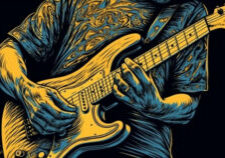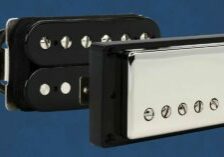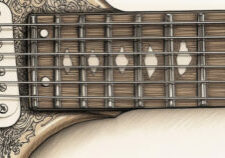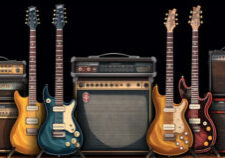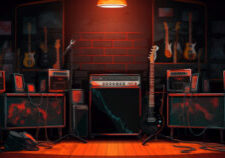Are you a metalhead looking to unleash the ultimate power of your Marshall amp? Look no further! In this article, we’ll dive deep into the world of Marshall amp settings for metal.
Imagine cranking up your amp and being able to achieve that bone-crushing, face-melting tone you’ve always dreamed of. We’ll show you the secrets to adjusting gain, fine-tuning EQ, and controlling volume for a powerful metal sound.
Get ready to rock harder than ever before!
Adjusting Gain for Distortion
You’ll want to crank up the gain to get that heavy distortion for your metal sound.
When it comes to adjusting the gain on your Marshall amp for a killer metal tone, there are a few things to keep in mind.
First, start by setting your amp to a clean tone with the gain at a lower level. This will serve as your baseline.
Tip: Gradually increase the gain until you achieve the level of distortion you desire. Be careful not to go overboard, as too much gain can result in a muddy and uncontrolled sound.
Finding the sweet spot may take some experimentation, but once you do, you’ll be rewarded with a powerful and aggressive tone.
Fine-tuning EQ for the Right Tone
To achieve the perfect metal tone, tweak the EQ settings on your Marshall amp for a more finely tuned sound.
Start by adjusting the bass knob to add weight and depth to your tone. Crank it up to get that heavy, thunderous low end that will make your riffs sound massive.
Next, turn the mids knob down a bit to create a scooped sound that is characteristic of metal music. This will give your guitar a more aggressive and punchy tone.
The treble will have a big impact on the saturation of the distortion. Keep the treble knob at a moderate level to retain clarity and definition in your playing. Too much treble can make your sound harsh. I like to turn the treble up until it has unpleasant piercing sound then back it down a little.
Finally, don’t forget to experiment with the presence knob. Increasing it will add more high-end sparkle while decreasing it will create a darker and smoother tone.
Remember, every guitarist has their own preference when it comes to EQ settings, so don’t be afraid to experiment and find the perfect balance that suits your playing style.
Volume Control for a Powerful Metal Sound
Adjusting the volume on your amplifier is crucial for achieving a powerful metal sound. When it comes to playing metal, you need that extra punch and aggression in your tone. By finding the right balance between power and control, you can create a sound that will make your guitar riffs cut through the mix and leave your audience in awe.
Start by setting your amplifier’s volume to a moderate level. This will allow you to have enough headroom to add gain and distortion without overwhelming the sound. As you increase the volume, you’ll notice that your tone becomes more aggressive and dynamic.
Tip: If you change the volume you will probably still need to go back and tweak the EQ and presence of your amp as this can change the characteristics of your sound.
Experiment with different volume levels to find the sweet spot that suits your playing style. Too much volume can result in a muddy and undefined sound, while too little can make your tone lack presence and impact.
Don’t be afraid to push the boundaries and crank up the volume when needed. Metal is all about creating a wall of sound and making a statement. Just make sure to keep an ear out for any unwanted distortion or clipping.
Getting Metallica / Thrash Sound on Your Amp
If you want to achieve that classic Metallica/thrash sound on your amp, start by dialing in a moderate amount of gain and adjusting the EQ settings to de-emphasize the midrange frequencies. This will give your guitar tone that aggressive and cutting edge that is characteristic of the genre.
Tip: Metallica’s sound from their early albums was known for having “scooped mids.” So on some amps, I will turn mids all the way down to zero and usually never more than 3.
Begin by setting your gain control at around 6 or 7 on a scale of 10. This will provide enough distortion to give you that heavy metal crunch, without sacrificing clarity.
Remember to experiment with these settings and trust your ears. Every amp and guitar combination is unique, so don’t be afraid to make adjustments until you find the perfect balance.
With a little tweaking, you’ll be able to achieve that classic Metallica/thrash sound that will make your amp roar with power.
How to Achieve a Good Modern Metal Tone
For a killer modern metal tone, crank up the gain and boost the midrange frequencies on your amp’s EQ.
By boosting the midrange frequencies, you will add clarity, punch, and definition to your tone, allowing your guitar to cut through the mix and stand out. This is especially important for metal, as it requires a powerful and aggressive sound.
To get started, set your amp’s gain control to a high level. You want to push it to the point where it starts to saturate and produce a thick, saturated tone. This will give you the foundation for a heavy metal sound.
Tip: to get more out of your amp, consider adding a boost or overdrive pedal. Ofter you won’t need to add to much gain or drive, but you can increase the level on the overdrive and adjust the tone knob. This can make a huge difference in boosting the low end, gaining saturation and getting that awesome metal “chug.”
Techniques and Tips for Metal Guitar
There are a few techniques and tips you can use to get that heavy metal guitar sound on your Marshall amp.
Palm Muting
Palm muting is a technique commonly used on the guitar to create a tight and percussive sound. It involves resting the edge of the palm on the strings near the bridge while playing, resulting in a muted and dampened tone. This technique is often employed in metal add a heavy percussive sound.
By controlling the pressure and position of the palm on the strings, guitarists can achieve various levels of muting, from a subtle dampening effect to a more pronounced chugging sound. Palm muting is also effective in controlling unwanted string vibrations and reducing sustain, allowing for more precise rhythmic playing and enhancing the overall groove of a song.
Downpicking
Downpicking on guitar refers to the technique of using a downward motion with the pick to strike the strings. It is commonly used in various genres of music, particularly in heavy metal to achieve a powerful and aggressive sound.
Downpicking requires precision and control, as it can be physically demanding due to the force needed to strike the strings consistently. This technique often plays fast and heavy riffs, creating a driving and intense rhythm. The alternative and often easier way to play fast metal riffs is using alternate picking (down stroke, then up stroke). However, alternate picking doesn’t deliver the same heavy impact that is needed in metal.
Frequently Asked Questions
Can I Use These Marshall Amp Settings for Genres Other Than Metal?
Yes, you can use these Marshall amp settings for genres other than metal. They can be versatile and adaptable to different styles of music, allowing you to achieve the desired sound for your specific genre.
What Are Some Common Mistakes to Avoid When Adjusting Gain for Distortion?
When adjusting gain for distortion, avoid cranking it up too much, as it can result in a muddy and indistinct tone. Also, be mindful of not neglecting the EQ settings, as they play a crucial role in shaping your sound.
Are There Any Specific EQ Settings That Work Well for Achieving a Classic Metal Tone?
When aiming for a classic metal tone, specific EQ settings can greatly help. Experiment with both cutting lows and scooping mids.
Can You Recommend Any Specific Effect Pedals That Pair Well With Marshall Amps for Metal Tones?
You should consider using a boost pedal, such as the Tubescreamer, to tighten up your high gain tones on a Marshall amp. Check out this post to learn about the best metal overdrive pedals on the market.
Conclusion: Amp Settings for Metal
Like a master blacksmith forging a powerful weapon, you have honed your skills and crafted a tone that cuts through the noise, leaving a trail of sonic destruction in its wake.
Now, armed with this knowledge, go forth and unleash your metal mastery upon the world.

